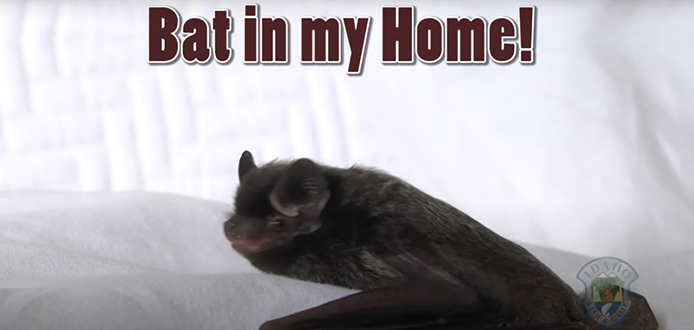||| FROM SAN JUAN COUNTY COMMUNICATIONS |||
San Juan County Health & Community Services wants to remind you of a few tips to make spring as enjoyable and healthy as possible. The bats are waking up, so here are some safety reminders as these nocturnal pollinators wake up from hibernation.
Don’t Touch Bats!
Most bats do not have rabies, but all human contact with bats should be avoided to prevent exposure to rabies virus. The virus is in the bat’s saliva and brain tissue, and can be spread to people through a bite, scratch, or other contact. Rabies is a preventable disease if treatment is given before symptoms appear. If untreated, rabies almost always leads to death.
It is common in spring or fall to see migrating bats temporarily roost outside on window screens, fence posts, piles of lumber, and other places. If you see a bat outside, leave it alone and do not touch it! It will probably be gone the following morning.
Infected bats may display unusual behavior such as inability to fly, flying during the daytime, and making a lot of noise. Healthy bats typically avoid contact with humans or animals and are usually not found resting on the ground.
Here are some steps to take to reduce the risk of rabies exposure:
- Don’t touch or handle wild animals, especially bats. Teach your children to never touch or handle bats, even dead ones. Have your children tell an adult if they find a bat at home, school, or with a pet.
- If you see a wild animal, leave it alone.
- Do not feed wild animals or keep them as pets.
- Keep bats out of your living space by bat-proofing your home.
- Vaccinate your pets. Pets can get rabies if bitten by a mammal infected with rabies, such as a bat. Protect your pets and yourself by getting them vaccinated against rabies on a schedule recommended by a veterinarian. Dogs, cats, and ferrets are required to be up-to-date on rabies vaccination in Washington.
Keep Bats Out
Bats are highly beneficial to people, as they play a vital role in preserving the environment and hunting night-flying insects (like mosquitoes). However, bats are unwanted guests because of the rabies exposure risk they pose.
Excluding bats from buildings can be done by you or by a professional. In attics and areas where large numbers of bats have been roosting for years, it is safer to hire a professional to clean up bat droppings. To see a list of common entry points used by bats, check out Washington Department of Fish & Wildlife’s website.
Trapping bats outdoors is not recommended. Traps can be fatal to bats if left unattended and can quickly become overcrowded. Bats also have excellent homing instincts and may simply return to the capture area.
Removing Live Bats from Your Home
If a person or a pet has come into direct contact with a bat or if you are uncertain of contact (e.g. woke up to find a bat in bedroom), call the San Juan County Health & Community Services (HCS) department at 360-378-4474.
This section is for removing bats from indoors and only for bats that do not require to be tested for rabies virus.
If a bat flies into your home through an entry point like an open door, window, or fireplace, here are steps to take to encourage the bat to leave:
- Isolate the bat with a path to escape outside. This will encourage the bat to leave through the entry point and prevent it from entering other rooms.
- At nightfall, turn off any lights in the room where the bat is confined, open all doors and windows that lead outside, and stand in the corner. Normally, the bat will fly around the room to orient itself, and then leave. This may take up to 20 minutes.
- If the bat does not leave, you may need to safely catch and release it away from people and pets. HCS does not provide bat removal services, but you can find the names of individuals or companies that do by looking up “Animal Control”, “Wildlife Control”, or “Pest Control”, either online or in your phone directory. Be certain that the company is familiar with public health guidelines and is willing to turn the bat over for rabies testing, if necessary. There are also resources online that provide tips for how to safely remove a bat from your home, like this video from Idaho Fish and Game.
If there is a dead bat in your home, it is still important to handle the bat safely.
Never handle a bat with bare hands. Wear thick gloves to pick up a dead bat or pick the bat up with a shovel or dustpan.
Place the bat in a sealed container, jar, or cardboard box, or place it in a plastic bag that is within another heavy-weight plastic bag.
Store in a cooler or refrigerator (not a freezer) until you have notified HCS at 360-378-4474. If you capture a bat after regular work hours, call HCS on the next workday. HCS is open Monday through Friday, 8 a.m. to 4:30 p.m.
What To Do After Direct Contact or Possible Contact
If you do not handle bats, the risk of contracting rabies is extremely small. However, if you think you have been bitten, scratched, or potentially exposed to rabies by contact with a bat, call HCS at 360-378-4474 to determine if the bat needs to be tested for rabies.
Only capture a bat that has been in direct contact with a person or pet, or if the bat was found in the room of someone who is uncertain of potential contact – it may need to be tested for rabies. Do not release a live bat or throw out a dead bat that has bitten, scratched, or had direct contact with a person or pet, unless HCS recommends testing is not necessary.
People usually know when a bat has bitten them. However, bats have very small teeth and claws, so markings may be difficult to see. Other scenarios that may be considered high-risk of exposure to rabies and may require the bat to be captured for testing include:
- A bat is found in a room with a deep sleeper.
- A bat is found in a room with an unattended child.
- A bat is found near a child outside.
- A bat is found in a room with a person under the influence of alcohol or drugs, or has another sensory or mental impairment.
If HCS determines that the bat in your home should be captured for testing, follow instructions for how to safely capture, euthanize, and submit the bat for rabies testing.
This is the third article in our spring safety series. Check out our articles about preventing tick exposure and preventing hantavirus exposure. Stay tuned for our next article to help islanders have a safe spring!
Relevant URLs:
- DOH Rabies (español)
- DOH Bats and Rabies Prevention (English only)
- DOH Rabies Vaccination Requirements for Dogs, Cats, and Ferrets (English only)
- King County Bats and rabies in King County, WA state (Google translate embedded)
- WDFW Living with wildlife: Bats (English only)
- WDFW Preventing conflicts (English only)
- How to Remove a Bat from your Home (video) (English only)
- DOH Safely Capturing Bats for Rabies Testing (English only)
- DOH Rabies Resources (español)
- DOH Don’t Touch Bats! (poster) (español)
- DOH Bats in Bedrooms: Assessing Risk (English only)
- DOH Rabies Activity in Washington (English only)
About San Juan County’s Department of Health & Community Services
San Juan County’s Department of Health & Community Services is responsible for community and environmental health, mental health and substance abuse programs, senior services, affordable housing projects, and more. The department has staff and offices on Lopez, Orcas, and San Juan Islands. For more information about San Juan County’s Department of Health & Community Services, visit www.sanjuancountywa.gov/1777/Health-Community-Services.
**If you are reading theOrcasonian for free, thank your fellow islanders. If you would like to support theOrcasonian CLICK HERE to set your modestly-priced, voluntary subscription. Otherwise, no worries; we’re happy to share with you.**









It’s great that the County is paying attention to bat ecology, but some of this information is misleading and not informed by actual local science. Bats in the islands are not pollinators, they do not hibernate, and only one local species is known to migrate. Our bats are active sporadically throughout the winter. The reason people encounter more bats in the summer is that baby bats are learning to fly (and how to be bats) and are more likely to end up where they shouldn’t (such as in your house). But the advice to not touch bats is good and applicable to all wildlife–both for their sake and yours. You can call Wolf Hollow about injured bats. Kwiaht collaborates with the State, has a permit to sample dead bats, and provides free technical assistance to landowners.